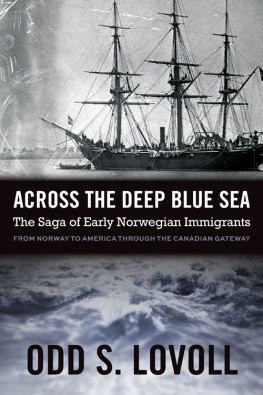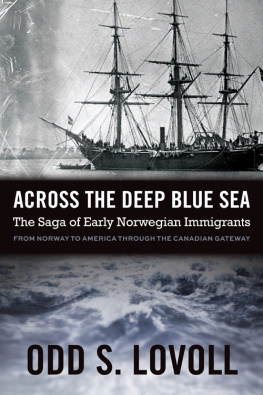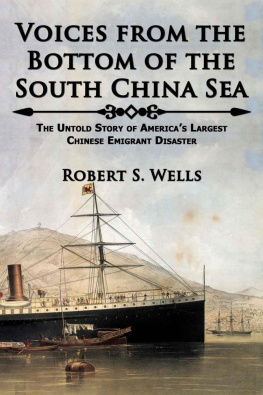Across the Deep Blue Sea
THE SAGA OF EARLY NORWEGIAN IMMIGRANTS
Odd S. Lovoll

This project received support from Institusjonen Fritt Ord / Freedom of Expression Foundation, Oslo, Norway Norsk faglitterr forfatter og oversetterforening / Norwegian Non-Fiction Writers and Translators Association, Oslo, Norway The Ella and Kaare Nygaard Foundation, St. Olaf College, Northfield, Minnesota
2015 by the Minnesota Historical Society. All rights reserved.
No part of this book may be used or reproduced in any manner whatsoever without written permission except in the case of brief quotations embodied in critical articles and reviews. For information, write to the Minnesota Historical Society Press, 345 Kellogg Blvd. W., St. Paul, MN 551021906.
www.mnhspress.org
The Minnesota Historical Society Press is a member of the Association of American University Presses. Manufactured in the United States of America
10 9 8 7 6 5 4 3 2 1
 The paper used in this publication meets the minimum requirements of the American National Standard for Information SciencesPermanence for Printed Library Materials, ANSI Z39.481984.
The paper used in this publication meets the minimum requirements of the American National Standard for Information SciencesPermanence for Printed Library Materials, ANSI Z39.481984.
International Standard Book Number
ISBN: 978-0-87351-961-8 (paper)
ISBN: 978-0-87351-972-4 (e-book)
Library of Congress Cataloging-in-Publication Data available upon request.
This and other Minnesota Historical Society Press books are available from popular e-book vendors.
Front cover: top: Nornen , Korvette, photo by Anders Beer Wilse, Norwegian Maritime Museum; bottom: photo by Louis W. Hill, MNHS collections
For Else
I DEDICATE THIS BOOK TO THE MEMORY OF MY WIFE,
ELSE OLFRID LOVOLL
(September 10, 1935May 3, 2011) .
Else was the love of my life.
She gave me much joy, love, and happiness and was the mainstay in my life and in my professional career during our fifty-five years together and the anchor and rock of our family.
She is greatly missed and much on my mind.
ACROSS THE DEEP BLUE SEA
Introduction
A cross the Deep Blue Sea takes a new look at an early chapter in Norwegian emigration history and expands its focus to include historical developments in the Norwegian homeland, the United States, and Canada. From 1850 and for some twenty years, Quebec, Montreal, and other Canadian port cities became the gateway for Norwegian emigrants to North America, replacing New York as the main destination. Norwegian sailing ships engaged in passenger traffic until 1874, after which they lost out in the competition with transatlantic steamships for this financially rewarding transport.
Much of history becomes a record of humanitys struggle for survival and search for happiness; indeed, this might be the theme of any historical work. In a larger context there is as well the desire for national expansion and aggrandizement, demonstrated frequently in commercial enterprise and in the aggressive pursuit of power by individuals and political entities. The Vikings were the first Europeans to set foot on North America around the year 1000, though their explorations did not lead to permanent settlements. The arrival of the French nearly five hundred years later and their claim of possession introduced a persistent European presence and a belligerent occupation and exploitation of resources; the creation of New France, which at the height of its power in the early 1700s covered an immense territory, manifested the force of European conquest. But the colonial powers competed, and Britain won in pitched battles against the French; the conflict resulted in New France in 1763 becoming a British possession.
In the American War of Independence, which began some twelve years later, the thirteen British colonies were the great winners and became the United States. A brief historical account of these early developments provides a deeper understanding of the situation in the 1800s. The nineteenth century is, however, of more immediate significance in the saga of immigration. The events leading up to confederation and the creation of the Dominion of Canada in 1867 were a significant stage in Canadas becoming a transcontinental nation.
At this time, Norwegian immigrants encountered a Canada moving along the path of full independence and prosperity. Norwegians had begun to emigrate to the United States a quarter century earlier. These two movements complemented each other, as almost all arrivals in Quebec joined their compatriots who had settled in the Upper Midwest. With the introduction of free trade, Norwegian sailing ships could engage in the lucrative timber trade from Canada to the British Isles. Some of the Norwegian sailing ships transported immigrants on their way west and timber on their return to Europe. This opportunity created wealth and expanded the size and reach of the Norwegian fleet. Norway became the most important foreign shipping nation in the Canadian timber trade. Although the underdog among its Nordic neighbors, Norway during its history back to the Middle Ages excelled in maritime activities. At mid-century both Norway and Canada experienced economic and greater political independence. In 1814 Norway had broken its long union with Denmark but entered into a dynastic union with Sweden. Norways advances in its economic and political life powered dissolution of the union.
Both Canada and the United States sought immigrants and engaged in aggressive campaigns through propaganda and emigration agents. The efforts to establish Norwegian colonies in Canada largely failed; only in the 1880s did Norwegians begin settling in Canadas prairie provinces. The emigration from Norway had great regional variations in intensity, but all parts of Norway were by the mid-1850s affected by the overseas exodus. The states of the Upper MidwestWisconsin setting the tone and later joined by Minnesota, Iowa, and othersengaged in persistent recruitment of European emigrants, with Nordic and German groups being the dominant settlers. Land-grant railroad companies played a significant role in the competition for immigrant settlers, and their efforts were supported by colonization agents and other financial interests. People were needed to settle and clear the land, to build the railroads, factories, and towns.
An extraordinary story unfolds in the following pages. At its base is the European expansion into North America. Uniquely, the Norwegian perspective expands the history of emigration to include aspects of the overseas exodus frequently overlooked in historical accounts; it treats the growth of a transportation system of sailing ships, the impact on coastal communities, and the composition and experience of the crew, including crew members who abandoned ship. Emigration is traced regionally, and the emigrants circumstances associated with the Atlantic crossing and landing in the Province of Quebec are outlined. Campaigns to attract immigrants and settlers are fully covered from different perspectives and add new information and insight to the motivating forces of the transatlantic exodus. The human drama of the emigration is emphasized, as is the individual challenge faced by people who during the sailing ship era sought a better life away from the homeland.
chapter 1

Context and Setting
T he phrase the Canadian gateway denotes the years from 1850 when Quebec City and other seaports in Quebec Province replaced New York as ports of entry for Norwegian immigrants on sailing ships directly from Norway to North America. In fact, the analogy of a gateway may also apply to the entirety of Canadas history. The driving force behind the dramatic shift was the opportunity for Norwegian sailing ships to engage in the lucrative transport of timber from Canada to ports on the British Isles after free trade replaced the earlier restrictive measures of mercantilism. On their crossing to Canada these ships might transport Norwegian immigrants, though most did not do so, carrying ballast instead. Vessels that transported immigrants secured cargo in both directions. Historian Jacob S. Worm-Mller maintains that much of the days of glory for Norwegian sailing ships derived from the trade with Quebec. These years viewed in a broad historical context represent a unique era in the history of the Norwegian exodus across the Atlantic and one that deserves a comprehensive scholarly treatment.















 The paper used in this publication meets the minimum requirements of the American National Standard for Information SciencesPermanence for Printed Library Materials, ANSI Z39.481984.
The paper used in this publication meets the minimum requirements of the American National Standard for Information SciencesPermanence for Printed Library Materials, ANSI Z39.481984.